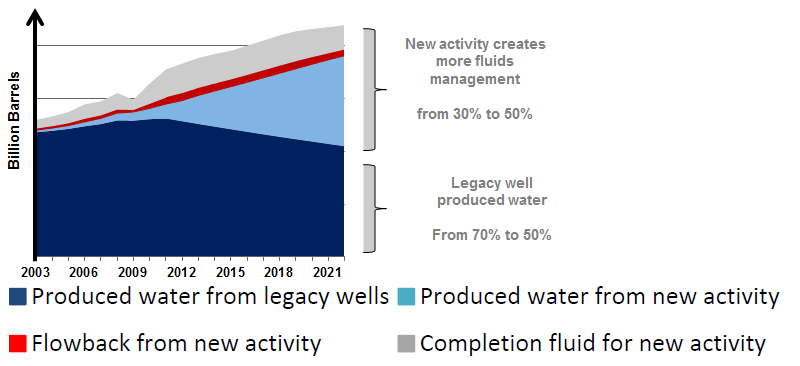Customer Logins
Obtain the data you need to make the most informed decisions by accessing our extensive portfolio of information, analytics, and expertise. Sign in to the product or service center of your choice.
Customer Logins
BLOG
Aug 20, 2013
Water challenges present market opportunities in the unconventional landscape
The US Energy Information Administration estimates global consumption of water for use in energy production at more than 400 billion barrels in 2010, and forecasts that it will more than double by 2035. Among the water-scarce southwestern states, the total water demand for hydraulic fracturing may account for less than 0.1 percent of consumable water; but within a county hosting high drilling and completions activity, it may account for as much as 30 percent of that area's available supply (Johnson County, Texas. Bureau of Economic Geology, Jackson School of Geosciences, The University of Texas at Austin). The, hyper-regional water demand generates stakeholder concerns that not only increasingly draw attention to water management and supply chain logistics but also could create significant roadblocks to development activity.
Our recent analysis shows that hydraulic fracturing of a well can require anywhere from 25,000 to 250,000 barrels of water. The acquisition cost of this water may be only tens of thousands of dollars, yet the fluid transportation and disposal costs for the same well may be much more. In addition, increasing water stress and continued regulatory pressures threaten to escalate costs further throughout the water value chain. In response to these pressures, volumetric and economic optimization of water management is necessary at both the play and well level. Operational variability across many different plays and the cost of water sourcing, reuse and disposal are key issues that we explore in two new IHS studies, The Future of Water in Unconventionals: Water Management Strategies and Market Opportunities.
We have found that each of the 13 plays covered in our research carries its own unique, hyper-regional water management challenges. For example, the Appalachian Basin is considered relatively water rich, while water stress in the Bakken creates substantial pressures on the cost of water acquisition, transfer, transport and storage. In the water-stressed Permian Basin in West Texas, horizontal drilling and hydraulic fracturing activity in recent years has increased the total volume of fluid handled by operators, creating new pressures there as well. The volumetric projection of water needs and wastewater production from unconventional resources in the Permian Basin is projected to grow substantially in the next ten years. What's more, volumetric projections in regions like the Permian Basin are adding billions of barrels of fluid into the broad landscape of water management. This new activity is creating significant opportunities for new products and services and has spurred the entry of newcomers offering operational innovation and technology development.
New activity from unconventional resources in the Permian basin is the future for water management opportunities

Just as the water management challenges vary by play, so too do the growth opportunities throughout the value chain. For example, today water transportation by truck dominates the oil and gas water management market. Driven by the need for field flexibility, truck-based hauling of oil field aqueous fluids has historically been the primary mode of fluid transportation, however a number of environmental and economic concerns are at play to erode this market spend. Similarly, truck transportation is costly in some regions due to distance travelled and can be as high as 80 percent of water management costs. Additional concerns with trucking include noise, environmental pollution, road degradation and an increased risk of automotive accidents. As such, lay-flat hose is becoming increasingly popular as operators seek a water transfer option for wastewater that is both dependable and easily deployable and IHS anticipates truck-based hauling market share to decline. Our analysis highlights the operational shift from trucks toward water transfer by pipes and hose, creating a significant new market opportunity in surface water transfer.
Likewise, in response to environmental and economic considerations, unconventional oil and gas operators are looking at direct-reuse of flowback and produced fluids as a likely solution. Today, approximately 16 percent of all completion fluids are comprised of recycled wastewater, IHS expects this to double by 2022, presenting a significant opportunity for economic and effective treatment technologies.
The unconventional oil and gas landscape today is opening up new energy frontiers and driving resurgence in North American manufacturing. Furthermore, the unique operational and supply chain challenges faced in the unconventional landscape are fueling innovation, entrepreneurism and environmental stewardship through the development and adoption of new fluid transportation systems. This challenge and growth opportunity is one of many within the water management business today.
Posted 20 August 2013
This article was published by S&P Global Commodity Insights and not by S&P Global Ratings, which is a separately managed division of S&P Global.
{"items" : [
{"name":"share","enabled":true,"desc":"<strong>Share</strong>","mobdesc":"Share","options":[ {"name":"facebook","url":"https://www.facebook.com/sharer.php?u=http%3a%2f%2fwww.spglobal.com%2fcommodityinsights%2fen%2fci%2fresearch-analysis%2fwater-challenges-present-market-opportunities-in-the-unconventional-landscape.html","enabled":true},{"name":"twitter","url":"https://twitter.com/intent/tweet?url=http%3a%2f%2fwww.spglobal.com%2fcommodityinsights%2fen%2fci%2fresearch-analysis%2fwater-challenges-present-market-opportunities-in-the-unconventional-landscape.html&text=Water+challenges+present+market+opportunities+in+the+unconventional+landscape","enabled":true},{"name":"linkedin","url":"https://www.linkedin.com/sharing/share-offsite/?url=http%3a%2f%2fwww.spglobal.com%2fcommodityinsights%2fen%2fci%2fresearch-analysis%2fwater-challenges-present-market-opportunities-in-the-unconventional-landscape.html","enabled":true},{"name":"email","url":"?subject=Water challenges present market opportunities in the unconventional landscape&body=http%3a%2f%2fwww.spglobal.com%2fcommodityinsights%2fen%2fci%2fresearch-analysis%2fwater-challenges-present-market-opportunities-in-the-unconventional-landscape.html","enabled":true},{"name":"whatsapp","url":"https://api.whatsapp.com/send?text=Water+challenges+present+market+opportunities+in+the+unconventional+landscape http%3a%2f%2fwww.spglobal.com%2fcommodityinsights%2fen%2fci%2fresearch-analysis%2fwater-challenges-present-market-opportunities-in-the-unconventional-landscape.html","enabled":true}]}, {"name":"rtt","enabled":true,"mobdesc":"Top"}
]}
